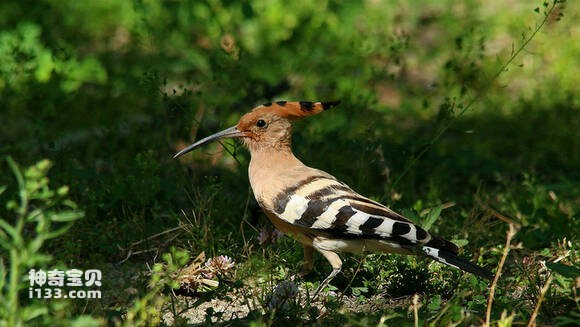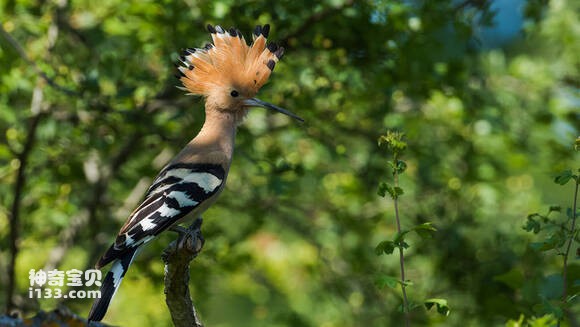Upupa epops
IUCN
LCBasic Information
Scientific classification
- name:Upupa epops
- Scientific Name:Upupa epops, Common Hoopoe in English, Hoopoe in French Huppe fasciee iالهدهدn Arabic
- Outline:Climbing birds
- Family:
Vital signs
- length:24.5-31.2cm
- Weight:53-90g
- lifetime:About 20 years
Feature
It's the national bird of Israel. It's a little unhygienic
Distribution and Habitat
It is mainly distributed in Europe, Asia and North Africa, and is widely distributed in China.
They live in open areas such as mountains, plains, forests, forest margins, roadside, river valleys, farmlands, grasslands, villages and orchards, especially in cultivated land on forest margins. In winter, it is mainly in low altitude areas such as the plain at the foot of the mountain, and in summer, it can go up to high altitude areas of 3000 meters. Common alone or in pairs scattered in the mountains or plains of the open land, arable land, orchards and other ground foraging, when frightened, or fly to the nearby small trees, or fly to a rock not far from the hillside.
Appearance
Wear the head, neck, chest light brown chestnut. The crown is darker and each feather has a black tip, more white spots before the posterior black tip. The chest is also stained with light wine color; The upper dorsal and upper wing coverts turn brown; Underback and shoulder feathers dark brown mixed with brownish white tips and feather margins; There are three bands of black, brown-white, black-brown and an incomplete white band between the upper and lower back, and the connected broadband surrounds both sides to the bottom of the wing bend; White waist; The base of the upper tail cover is white, the tip is black, and some of the tip margin is white; The tail feathers are black, and there is a white spot in the middle of each feather from both sides to the near end to form a curved transverse band. The outer wing is black, turning inward to black brown, the middle and large overlying feathers have brown-white proximal stripes, the primary feathers (except the first one) have a series
Details
Dyson (scientific name: Upupa epops) English Common Hoopoe, Hoopoe, French Huppe fasciee, Arabic Yan Yan is more than more, there are 8 subspecies.

The appearance of the Dai Sheng bird is extremely unique, with colorful feathers on the top of the head, a long and narrow beak, a patchwork of feathers, an alert and upright temperament, and an unswerving habit, making it one of the symbols of religion and legend since ancient times. In China, the Dai Sheng bird symbolizes peace, happiness and happiness. There are many poems in ancient China praising the Dai Sheng Bird.
Can pass on the spring news, if to Pengshan Mo release.
Green forest warm rain full mulberry worm, Sheng rain from the wet green red. There are also spring thought forbidden, Shun Huachi appeal spring breeze.
"Dai Sheng Bird" color one ounce silver coin is also known as "China rare bird" color silver coin. It is a single set of color silver coins issued by China Gold Coin Corporation. It was launched by China Gold Coin Corporation during the Spring Festival in 2000, which means "at the beginning of the millennium, Dai Sheng Ruyi" is a very auspicious and profound color commemorative silver coin.
< img SRC = "/ static/upload/images / 20230419/2023041911015722. JPG" title = "2023041911015722 JPG" Alt = "the hoopoe silver _ nine ray image converter. JPG" / >
It feeds mainly on the insects and larvae of ð«, orthoptera, Hymenoptera, Coleoptera and lepidoptera, such as locusts, mole crickets, stoneflies, scarab beetles, insects, hoppers, moths and butterfly larvae and adults, as well as other small invertebrates such as worms Foraging in the forest edge of grass or cultivated land, often insert the long mouth into the soil to feed.

Breeding males often fight to protect their territory. The two sides approached each other, first facing each other with their crowns high and their mouths stretched down as far as possible, suddenly biting the tips of their mouths, pulling in a straight line like a tug-of-war to maintain a certain safe distance, then the two joined together, flapping their wings together, falling off, and continuing to impact each other on the ground until one gave way.
The breeding period of Dai Sheng is from April to June. Breeding in pairs. Competition between males is sometimes seen. The female watches from the sidelines and eventually pairs up with the winner. Nesting is usually done at the edge of a forest or in a natural tree hole on either side of a forest road or in a woodpecker's abandoned hole. The size and diameter of the hole vary greatly with the environment, and in the farmland area at the foot of the mountain where there is a lack of tree holes, they also nest between the wall holes of abandoned houses and the cliff walls, and even lay eggs under the pile of dry branches on the ground. The nest consists of plant stems and leaves, sometimes mixed with roots, feathers, and hair.

Dai Sheng breed 1 litter a year, usually 6-8 eggs per litter, occasionally as few as 5, as many as 9, and even as many as 12 eggs. The eggs are long oval and pale blue or grayish brown in color. The female lays her first egg and begins to incubate. The eggs are incubated by the female for 18 days. Young birds are late sex. The chicks weigh only 3.5 grams when they hatch, the body length is 45 mm, the whole body flesh is red, only the top of the head, the middle line of the back, the thigh furrow, the shoulder and the tail have white feathers. Male and female birds raise young together. After 26 to 29 days of feeding, the chicks can fly and leave the nest. Because the faeces of the chicks are not treated by the parent birds, and the female birds discharge a black and brown oily liquid from the tail glands during incubation, making the nest very dirty and smelly, Dai Sheng has the common name of "smelly aunt".
On May 29, 2008, Israeli President Shimon Peres declared the Dyson bird the national bird of Israel in Jerusalem. As part of the 60th anniversary of the founding of the state of Israel, the event was initiated by the Israel Society for the Conservation of Nature to draw the attention of the nation to bird conservation. By one count, 150,000 Israelis voted on 10 local bird candidates. The opinion of the public accounted for 75% of the vote, and that of a panel of experts made up of Israeli poets, politicians and academic representatives accounted for 25%. The bird was chosen because it is beautiful, dutiful and takes good care of its young.
Listed on the International Union for Conservation of Nature Red List of Threatened Species (IUCN) for 2020 ver 3.1 - Not Threatened (LC).
It was included in the List of Land Wild Animals under State Protection that are beneficial or have important economic and scientific research Value (Item 278) issued by the State Forestry Administration of China on August 1, 2000.
Protect wild animals and eliminate wild meat.
Maintaining ecological balance is everyone's responsibility!








